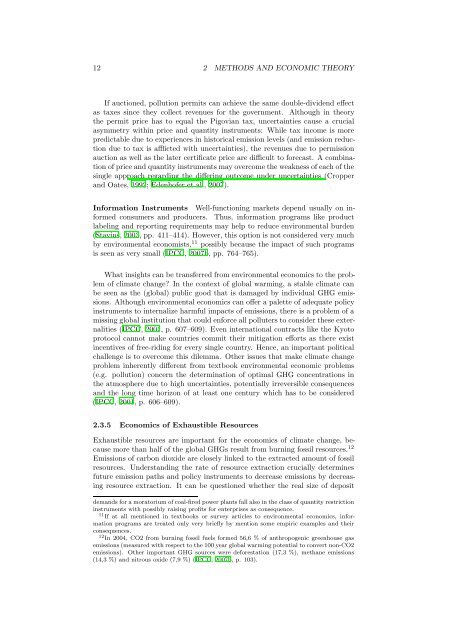Modeling Climate Policy Instruments in a Stackelberg Game with ...
Modeling Climate Policy Instruments in a Stackelberg Game with ...
Modeling Climate Policy Instruments in a Stackelberg Game with ...
You also want an ePaper? Increase the reach of your titles
YUMPU automatically turns print PDFs into web optimized ePapers that Google loves.
12 2 METHODS AND ECONOMIC THEORY<br />
If auctioned, pollution permits can achieve the same double-dividend effect<br />
as taxes s<strong>in</strong>ce they collect revenues for the government. Although <strong>in</strong> theory<br />
the permit price has to equal the Pigovian tax, uncerta<strong>in</strong>ties cause a crucial<br />
asymmetry <strong>with</strong><strong>in</strong> price and quantity <strong>in</strong>struments: While tax <strong>in</strong>come is more<br />
predictable due to experiences <strong>in</strong> historical emission levels (and emission reduction<br />
due to tax is afflicted <strong>with</strong> uncerta<strong>in</strong>ties), the revenues due to permission<br />
auction as well as the later certificate price are difficult to forecast. A comb<strong>in</strong>ation<br />
of price and quantity <strong>in</strong>struments may overcome the weakness of each of the<br />
s<strong>in</strong>gle approach regard<strong>in</strong>g the differ<strong>in</strong>g outcome under uncerta<strong>in</strong>ties (Cropper<br />
and Oates, 1992; Edenhofer et al., 2007).<br />
Information <strong>Instruments</strong> Well-function<strong>in</strong>g markets depend usually on <strong>in</strong>formed<br />
consumers and producers. Thus, <strong>in</strong>formation programs like product<br />
label<strong>in</strong>g and report<strong>in</strong>g requirements may help to reduce environmental burden<br />
(Stav<strong>in</strong>s, 2003, pp. 411–414). However, this option is not considered very much<br />
by environmental economists, 11 possibly because the impact of such programs<br />
is seen as very small (IPCC, 2007b, pp. 764–765).<br />
What <strong>in</strong>sights can be transferred from environmental economics to the problem<br />
of climate change? In the context of global warm<strong>in</strong>g, a stable climate can<br />
be seen as the (global) public good that is damaged by <strong>in</strong>dividual GHG emissions.<br />
Although environmental economics can offer a palette of adequate policy<br />
<strong>in</strong>struments to <strong>in</strong>ternalize harmful impacts of emissions, there is a problem of a<br />
miss<strong>in</strong>g global <strong>in</strong>stitution that could enforce all polluters to consider these externalities<br />
(IPCC, 2001, p. 607–609). Even <strong>in</strong>ternational contracts like the Kyoto<br />
protocol cannot make countries commit their mitigation efforts as there exist<br />
<strong>in</strong>centives of free-rid<strong>in</strong>g for every s<strong>in</strong>gle country. Hence, an important political<br />
challenge is to overcome this dilemma. Other issues that make climate change<br />
problem <strong>in</strong>herently different from textbook environmental economic problems<br />
(e.g. pollution) concern the determ<strong>in</strong>ation of optimal GHG concentrations <strong>in</strong><br />
the atmosphere due to high uncerta<strong>in</strong>ties, potentially irreversible consequences<br />
and the long time horizon of at least one century which has to be considered<br />
(IPCC, 2001, p. 606–609).<br />
2.3.5 Economics of Exhaustible Resources<br />
Exhaustible resources are important for the economics of climate change, because<br />
more than half of the global GHGs result from burn<strong>in</strong>g fossil resources. 12<br />
Emissions of carbon dioxide are closely l<strong>in</strong>ked to the extracted amount of fossil<br />
resources. Understand<strong>in</strong>g the rate of resource extraction crucially determ<strong>in</strong>es<br />
future emission paths and policy <strong>in</strong>struments to decrease emissions by decreas<strong>in</strong>g<br />
resource extraction. It can be questioned whether the real size of deposit<br />
demands for a moratorium of coal-fired power plants fall also <strong>in</strong> the class of quantity restriction<br />
<strong>in</strong>struments <strong>with</strong> possibly rais<strong>in</strong>g profits for enterprises as consequence.<br />
11 If at all mentioned <strong>in</strong> textbooks or survey articles to environmental economics, <strong>in</strong>formation<br />
programs are treated only very briefly by mention some empiric examples and their<br />
consequences.<br />
12 In 2004, CO2 from burn<strong>in</strong>g fossil fuels formed 56,6 % of anthropogenic greenhouse gas<br />
emissions (measured <strong>with</strong> respect to the 100 year global warm<strong>in</strong>g potential to convert non-CO2<br />
emissions). Other important GHG sources were deforestation (17,3 %), methane emissions<br />
(14,3 %) and nitrous oxide (7,9 %) (IPCC, 2007b, p. 103).
















